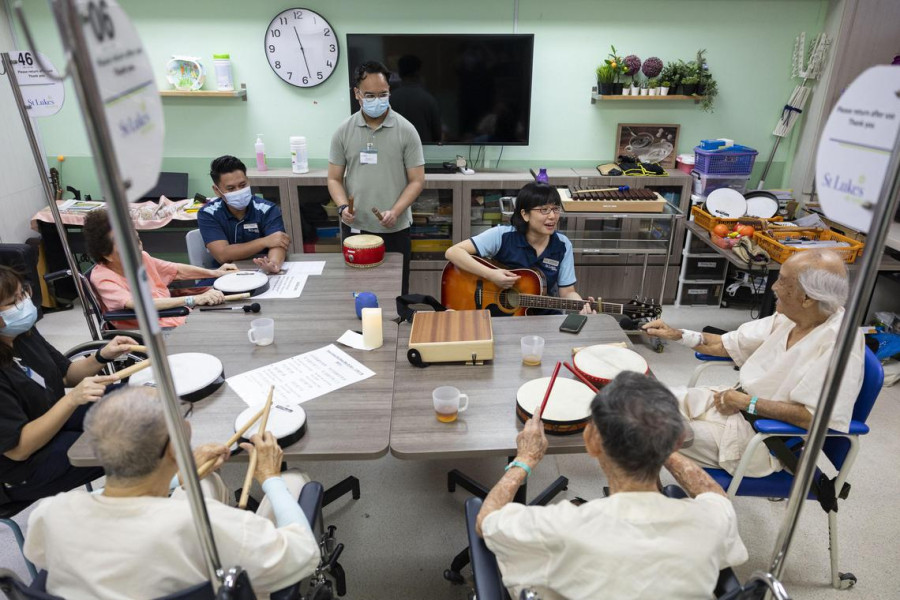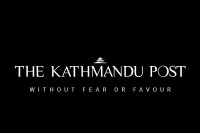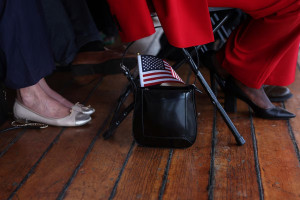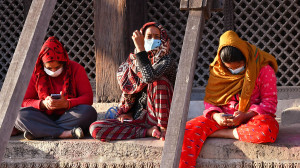World
When melody meets medicine: A look at Singapore’s growing music therapy scene
Singapore’s first postgraduate course in music therapy nurtures a growing community of trained professionals using music for healing and emotional care.
The Straits Times
It is not uncommon for musicians to have a dream stage. Perhaps a sold-out arena or a dim jazz bar steeped in soul. Bakti Khair’s is a hospital ward.
Becoming a music therapist was a hope he held onto for more than seven years. Through being a primary school music teacher, getting married and becoming a father, the dream never wavered.
As he put it: “Music therapy connects music, psychology and healthcare.”
A burgeoning scene here, the clinical and evidence-based profession uses music to improve physical, emotional, cognitive and social well-being. Its use ranges from palliative and dementia care to pain management and early childhood intervention.
Bakti encountered music therapy while doing research for an undergraduate assignment at Lasalle College of the Arts. He completed his degree in music composition in 2017.
But at the time, there was no music therapy programme in Singapore for him to pursue his interest further.
“It’s all based on my desire to help,” said the 33-year-old. “I wanted to use whatever knowledge or background of music I have to create some change.”
First postgrad course in Singapore
Bakti considered training in New Zealand. Then in 2024, Lasalle launched the country’s first postgraduate programme in music therapy, opening the door for aspiring practitioners to be trained locally.
“Its amazing, something that I’ve always wanted to do,” he told The Straits Times in March while on an eight-week clinical placement with St Luke’s Hospital, where he worked closely with dementia patients.
Dr Indra Selvarajah, leader of Lasalle’s music therapy programme, said the two-year course arose in response to growing interest in the profession and was oversubscribed.
Of late, Singapore has seen a surge of curiosity surrounding music’s role in community and wellness – seen, for example, in the growing popularity of sound baths. But music therapy, Dr Selvarajah stressed, is a clinical profession which requires specialised training at a tertiary level.
The programme took three years of planning, research and consulting with international music therapy experts to design. It was done in close collaboration with the Association for Music Therapy in Singapore (AMTS).
“We have 19 students, a good mix of local and international students from countries such as Malaysia, Japan and the Philippines,” she said, noting that regional interest in the field is growing.
Programme lecturer Eta Lauw said the course marks a crucial step towards making music therapy more accessible in Singapore.
It allows locals keen on studying music therapy to do so at home, without the burden of hefty overseas tuition fees.
Key to this, she added, is that while music may be universal, its emotional and cultural resonance varies widely.
“There are a lot of very specific cultural elements to it,” said the Australia-trained therapist, adding that many who studied abroad have to make significant adaptations to reshape their training to fit Singapore’s context.
Now, students are able to learn within a local context, complete clinical placements and observe how music therapy is practised here.
Dr Selvarajah said she is excited for the course to expand the presence and impact of music therapy in Singapore.
“Any kind of recognition that is forthcoming will rely on the growth and actual increase in music therapists. This is where our programme plays a vital role.”
An existing ecosystem
Music therapy has had a presence here long before Lasalle offered its course.
AMTS has been around since 2007. Even then, its president Tan Xueli noted, some of its members had been practising in Singapore for more than two decades.
The association has grown steadily, from just 11 professional members at its founding to 44 today. Counting associate and student members, the total number stands at 74.
Most of its members work in acute and community hospitals, hospices as well as nursing homes, with a handful in private practice.
The field has a prominent presence in palliative care, as the broader healthcare community increasingly recognises the importance of quality of life for terminal patients.
“When that shift happens, the creative arts often play a very big part. You bring in creative art therapies at that point, because you are looking at quality of life, comfort care, pain management and more of the psychosocial aspects,” said Dr Tan. She is the principal music therapist and music therapy lead at St Luke’s Hospital’s Rehabilitation Department.
At St Luke’s Hospital, senior music therapist Camellia Soon, 37, specialises in palliative and dementia care.
With patients who are nearing the end of their lives, she said, much of the work involves helping them navigate grief – not just over death, but also over the inevitable loss of identity and ability.
It could be grief from no longer being able to do the things they used to do, such as going to work or cooking for their families, Ms Soon said.
“If they have awareness of their illness, they also know that this might be their last New Year, last birthday,” she added.
Physical, emotional and cognitive benefits
One of Ms Soon’s patients was a terminally ill elderly man with a neurological disorder. A stand-offish character, he was estranged from his family and was often caught in states of delusion.
Over the course of three months, he would sometimes weep when Ms Soon played spiritual music, such as hymns – though he could never quite name which songs touched him most.
Eventually, he began to recognise Ms Soon by name and told her he felt “lighter”.
“My aim was not to make him happy, but to use music to allow him to open up, enable the grief to be expressed and find closure,” she said.
Then, one day, seemingly out of nowhere, he shared two songs with her: Fated by Hong Kong singer Andy Lau and First Of May by English pop group the Bee Gees, both reflections on time and loss.
With what Ms Soon described as “intense clarity”, he walked her through specific, vivid memories from his life. He died the following week.
“Music can unlock something I cannot do through just talking,” said Ms Soon, adding that some patients may never have ventured into those memories without the emotional nudge of a particular song.
Music therapy also helps dementia patients in physical, emotional and cognitive ways, said Dr Chan Kin Ming of Chan KM Geriatric and Medical Clinic.
Learning to play instruments can boost short-term memory and attention span, while using music to soothe agitation and aggression can be an effective alternative to medication, he said.
Music therapists do not just work with elderly patients.
At Thye Hua Kwan Moral Charities, music therapist Farhana Rizaini, 34, works with children with developmental needs.
Using a mix of musical activities – from playing instruments to learning prepositions through song cues to reading stories set to music – Ms Farhana tailors each session to meet their needs.
She remembers working with a child who would cry from fear of the guitar and a sensitivity to fast-paced music.
With consistent encouragement from both the teacher and a psychologist, the child was gradually able to tolerate louder and faster-paced music, and actively participate in most activities.
“The child can now sing along to familiar tunes, functionally play on a variety of instruments, from shakers to drums to even the guitar,” Ms Farhana said, adding that the child is also able to play games such as “peek-a-boo” to accompanying music.
Push for safe practice and recognition
Dr Tan pointed out: “Music is powerful. We can use music for all these benefits, but flip the coin – because music is powerful, you can also do harm.”
She spent many years working in pain management at a burns and trauma hospital department in the US.
Certain songs tied to painful experiences can trigger distressing emotions or traumatic memories.
That is why music therapists require specialised training to assess each individual’s emotional and psychological landscape, she said.
Where music may be triggering, therapists either avoid those cues or use them constructively to help patients process and work through deep-seated emotions.
Singapore’s music therapy community has been steadily stepping up efforts to advocate for the profession’s formal recognition as part of the allied health sector.
This recognition carries important implications, from enabling patient subsidies and student funding to broadening access to music therapy across the healthcare system.
Alongside the launch of Lasalle’s programme, AMTS has published several public resources in recent years. They include a Code of Ethics and Professional Standards, to guide local therapists and prepare the profession for integration into the allied healthcare framework.
In Singapore, said Dr Tan, music therapy can be an entryway for emotional expression in a society that often shies away from confronting difficult feelings.
How Singapore’s rich multiculturalism can be more deeply woven into music therapy is something Bakti hopes to explore in his practice.
“Perhaps the collaborative, community-building aspects of Malay music could be used in group music therapy sessions, or the five-tone Chinese scales could be used to induce certain moods for patients,” he said.
When song lyrics speak about loss or longing, people are able to externalise their emotions and project themselves onto the music, Dr Tan said. “It makes it, in a way, more acceptable to talk about negative emotions.”
Ms Soon added: “We are all musical beings. We have musical memories and there’s resonance. You don’t have to be able to play an instrument or sing to feel connected to music.”
In association with ANN.




 13.12°C Kathmandu
13.12°C Kathmandu





.jpeg&w=300&height=200)





%20(1).jpg&w=300&height=200)

